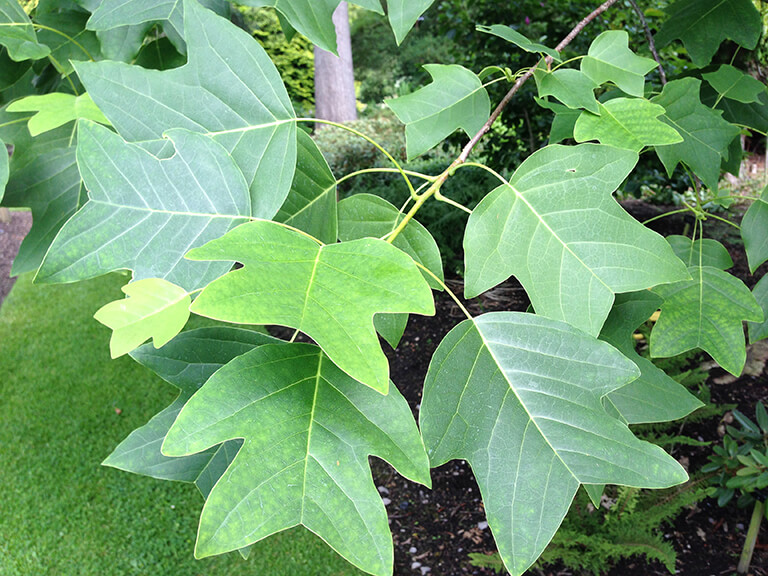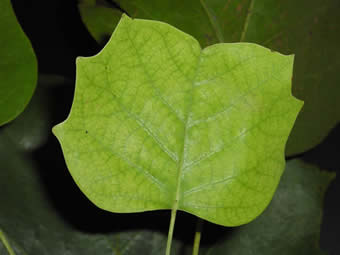tulip tree leaf venation
Pinnate Leaf type and persistence. Leaves turn clear yellow in autumn.
Enh 522 St363 Liriodendron Tulipifera Tuliptree
The leaves are lobed and the flowers are yellow.

. Leaflets are 4 inches. Consists of four short lobes with an inversely cordate notched apex. The lower epidermis and most of the spongy mesophyll was removed before freezing and lyophilizing the tissue.
This type of venation is generally found in dicot leaves. Leaves are glossy green above with a pale green underside changing to golden yellow in the fall. The Tulip Tree is botanically called Liriodendron tulipifera.
Their shape is unusual the so-called lyre. Types of compound leaves. If you grew the tree yourself you know how old it is.
Place the cutting in a bucket of water with rooting hormone added per package directions. Liriodendron tulipifera or Yellow Poplar is a deciduous tree that may grow 90 to 120 feet tall and takes its name from its greenish-yellow heartwood and attractive tulip-like flowers. Kentucky was home to some of the most.
Tulip trees that are a few decades old will usually flower reliably every year. Types of Leaf Simple Compound Single leaf blade Leaf has number of leaflets eg mango peepal Pinnately Palmately Compound Compound Neem rose Silk cotton Venation. What is type of venation in cassia leaf.
The effective concentration at which a substance is delivered to the minor venation via the transpiration. The simple tulip tree leaves have recognizable prominent veins stretching from the midriff to each pointed lobe. Start checking soil temperatures next week a couple of times per week to see where they are heading.
Tuliptree is easy to remember for its leaves which are shaped roughly like tulip flowers with rounded bases and square-lobed tops. Cassia leaf has reticulate venation. Tulip Tree These trees should be pruned in fall after the leaves have dropped or in early spring before the sap starts to flow March.
Leaf type and persistence. Pinnate leaves palmate leaves and double pinnate leaves. Along with it you will also want to add compost.
When propagating a tulip tree from cuttings line a bucket with burlap then fill it with potting soil. Branches have a simple alternate leaf pattern with pinnate leaf venation and 4 8 inch orbiculate shaped leaves that are a bright green on the surface and paler beneath. It is 168 feet tall.
It can but you may need to prep the soil first. Shortly after budding the leaves are yellow until soon thereafter turn green and in the autumn take on a pretty orange to bright red color. Bright green on top paler green underneath.
There are a number of types of compound leaves and knowing about them can help make tree identification easier. Often obscured by leaves at the tips of branches. It occurs in all counties in Kentucky on rich well-drained soils in mixed mesophytic associations.
The flowers are yellowish-green with a touch of orange on the outside. It looks a bit like a tulip flower. Made up of 68 pairs leaflets and one terminal leaflet.
The unique shape of the glossy green poplar leaves gives rise to common names such as fiddle trees because the rounded cut sides have a violin shape. Autoradiograph of tissue from an attached tulip tree leaf exposed to 14 CO 2 for 5 min and to normal atmosphere for 85 min. If you bought your tree from a nursery it may be hard to tell the trees age.
Cut the branch just outside of the swollen area where it attaches to the tree. Tulip trees can be identified by the shape of their leaves. Tulip tree is a large stately tree with a long clear trunk and a pyramidal crown.
Margin entire lobes pointed. Oak and cherry tree leaves have pinnate venation. The tree likes Sun to half-shade at the location and the soil should be permeable soils.
The trees are best planted in early spring once the final frost has passed. My bet is still always on the 3rd week of December as the optimal planting window. Leaf type and persistence.
Follow the package directions to determine the amount to apply. Deciduous Leaf blade length. My advice keep those tulip bulbs chilling for now.
Theyll grow rapidly at first more than 25 inches a year then slow as they get older. Rake the mulch back around the base of the tree. From left to right.
It is the largest member of the magnolia family in New England and one of the tallest hardwoods in eastern North America with a tall straight trunk reaching up to 200 feet 65m in height. The odds are a tulip tree that wont flower just isnt old enough to produce blooms. Youll want to take the tulip tree cuttings in the fall selecting branches 18 inches 455 cm or longer.
Tulip poplar is one of the tallest of the native American hardwoods. 4 to 8 inches. Each leaf is simple wide with venation.
Yellow poplar leaves are around 6 15 cm long and up to 8 20 cm wide. Although a rather large tree Tulip-Poplar could be used along residential streets with very large lots and. Tulip trees do not flower until they are at least 15 years old.
The bark of the red oak is smooth and gray. The Tree is a deciduous tree it will be 5 - 20 m 16 - 66 ft high. Attractive 2 inch-tall tulip-like flowers are yellow-green with an orange band at the base of each petal.
The Kentucky Champion tree is in Beaver Creek McCreary county. If needed a product called ClayMend and similar products can help to improve the pH of red clay soil. Department of Agriculture plant hardiness zones 5 through 9 tulip tree is used as a shade tree.
The time to make a long lasting effect on the form and structure of the plant is when the tree is young. If growth and flowering are slow apply another dose of fertilizer to promote leaf growth and blooming. Seeds Tulip trees produce many seeds each year starting when they are 15 to 20.
There are two classifications you need to know for tree identification. Leaves are alternate simple 46 inches long and broad tip notched or V-shaped at the center with 2 lobes near the tip and 2 or 4 lobes on the lower sides. 4 to 8 inches Leaf color.
Fruit cone nut and seed descriptions. The veins extend from the midrib to the leaf margin. Dark green and glossy on top paler green underneath.
Tulip poplar is currently the state tree of Kentucky. The pH of the soil should be between 45 and 75 with 66 to 75 being the optimal pH for a tulip poplar. If needed a few small branches can be removed in summer after the leaves have reached full size.
If you dont have one invest in an inexpensive soil thermometer. Apply the fertilizer to the soil around the base of the tulip tree. Examples of trees with compound leaves include ash trees walnut trees hickory trees and horse chestnut trees.
Water the tree thoroughly. Deciduous foliage of the Tulip Poplar tree turns a beautiful golden yellow in the fall. Get them in the ground by end of December.
Flower arrangement shape and size. Older trees have a thin-skinned bark. The leaves are about 20 cm 8 inch long and sit on a up to five inches long yellowish stalk.
The smooth green leaves are broadly lobed and turn vivid golden yellow in fall.
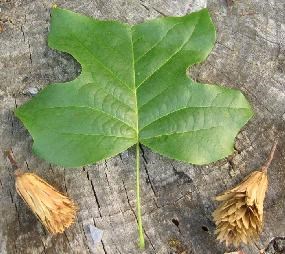
Tuliptree Shenandoah National Park U S National Park Service

What S In A Leaf Arnold Arboretum Arnold Arboretum

Yellow Poplar Natural Resource Stewardship
Tulip Tree Liriodendron Tulipifera
Tulip Tree Liriodendron Tulipifera
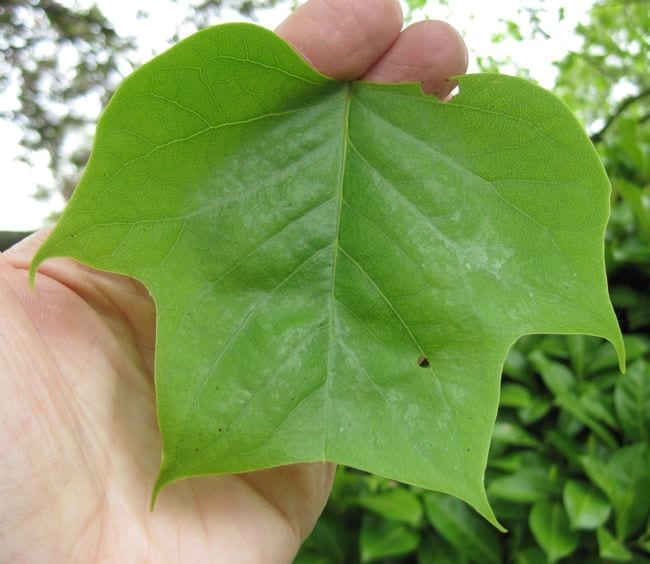
Tulip Tree Tree Guide Uk Tulip Tree Identification

Tulip Poplar Department Of Horticulture
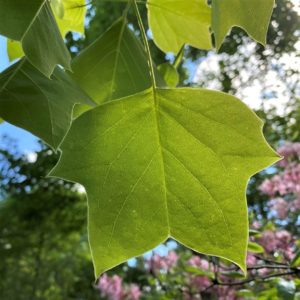
Common Tree Leaf Id Palmate Leaves Tyler Arboretum
Tulip Tree Liriodendron Tulipifera
Enh 522 St363 Liriodendron Tulipifera Tuliptree

Identifying The Yellow Poplar Tree Tree Leaf Identification Poplar Tree Tulip Poplar Leaf
Thinking Of Planting A Tulip Poplar Tree Gardening Q A With George Weigel Pennlive Com
Tulip Tree Liriodendron Tulipifera

The Tulip Tree Halifax Tree Project

Liriodendron Tulipifera Tulip Poplar Tulip Tree Yellow Poplar Yellow Poplar North Carolina Extension Gardener Plant Toolbox
